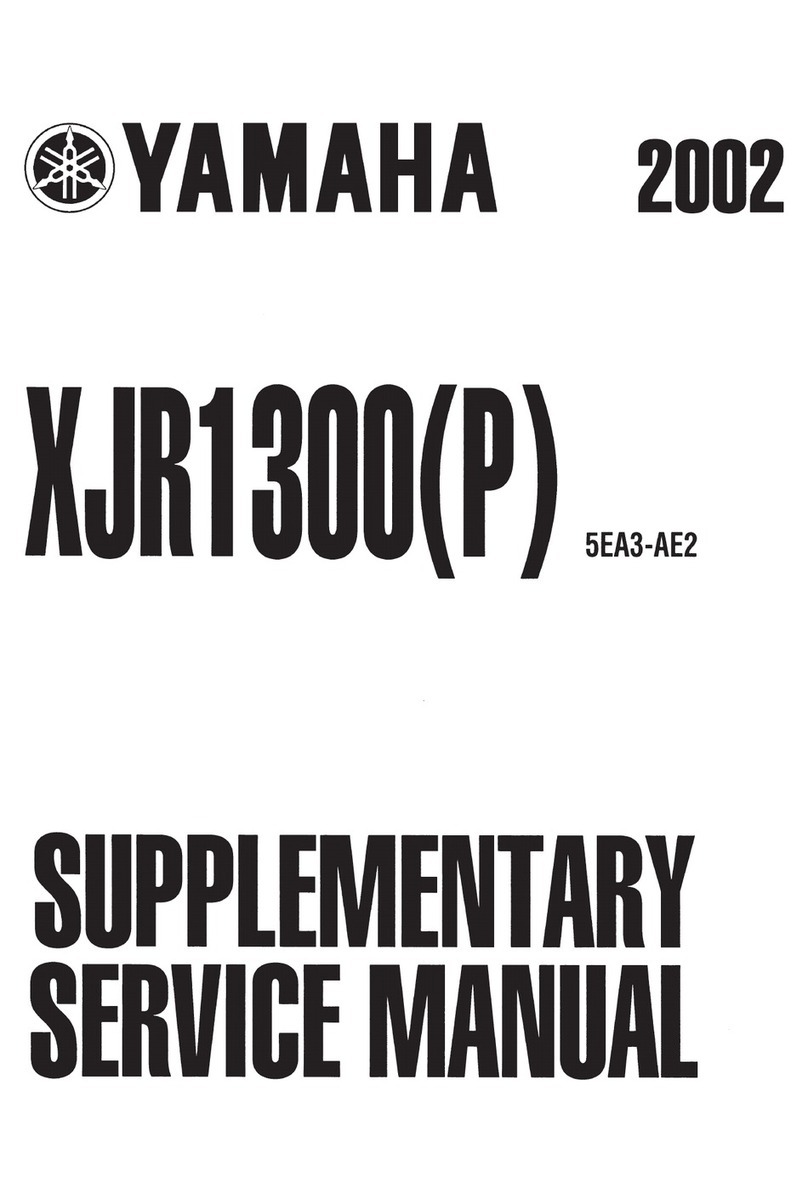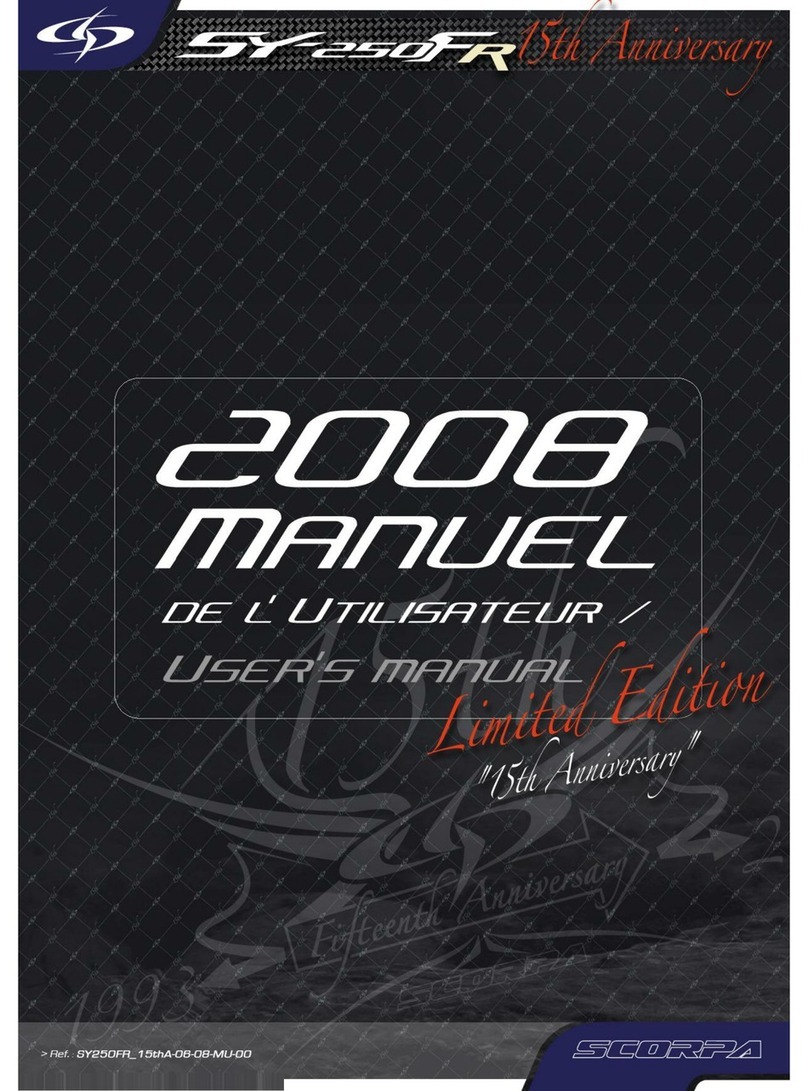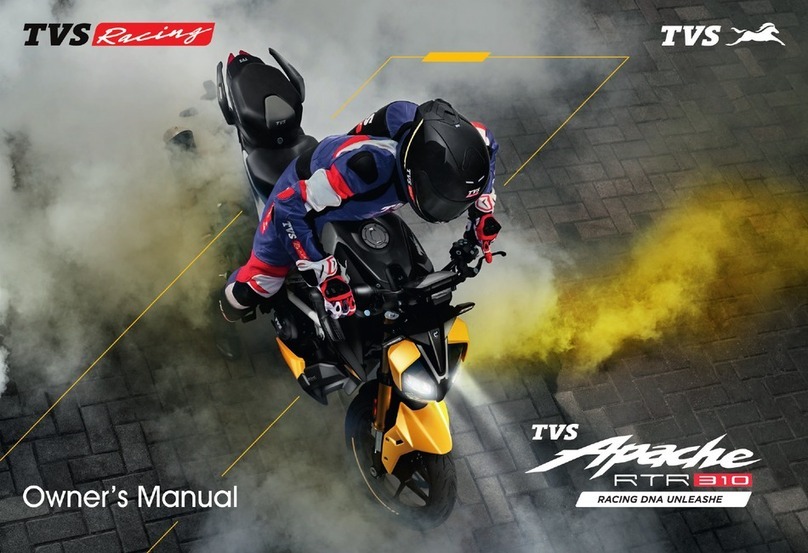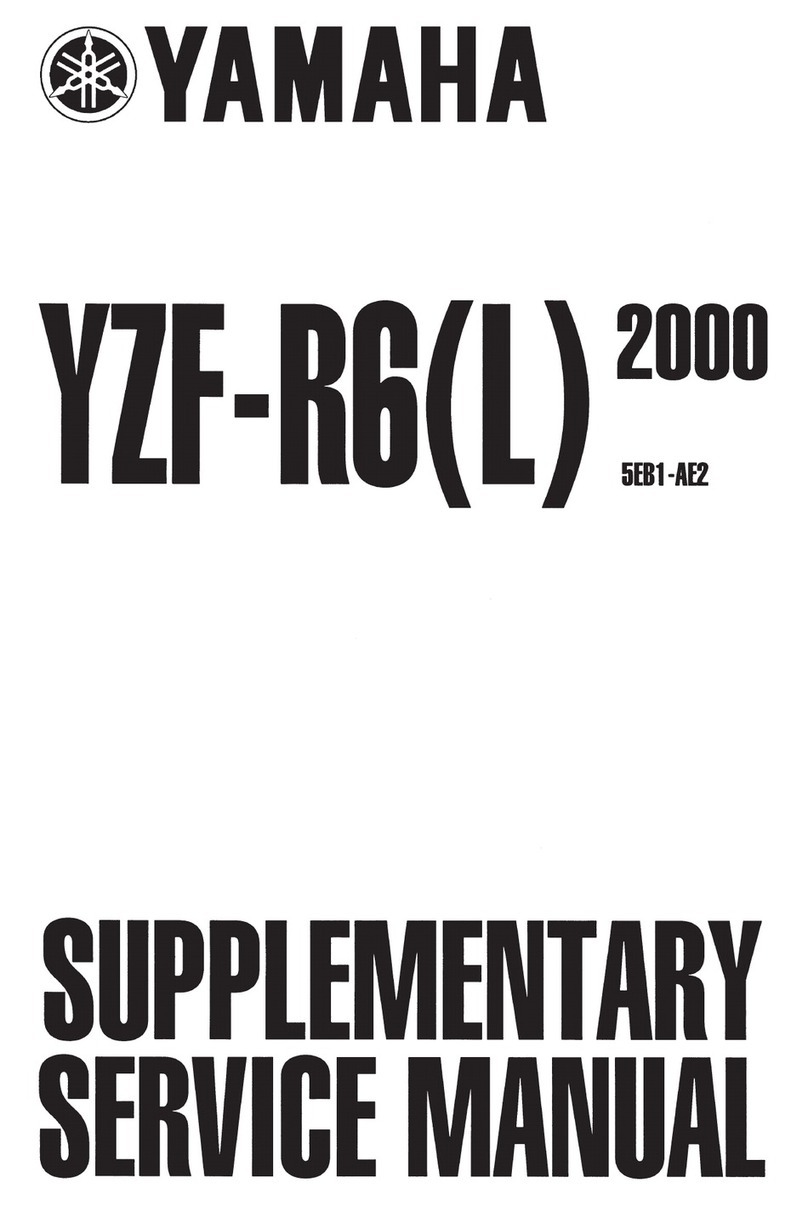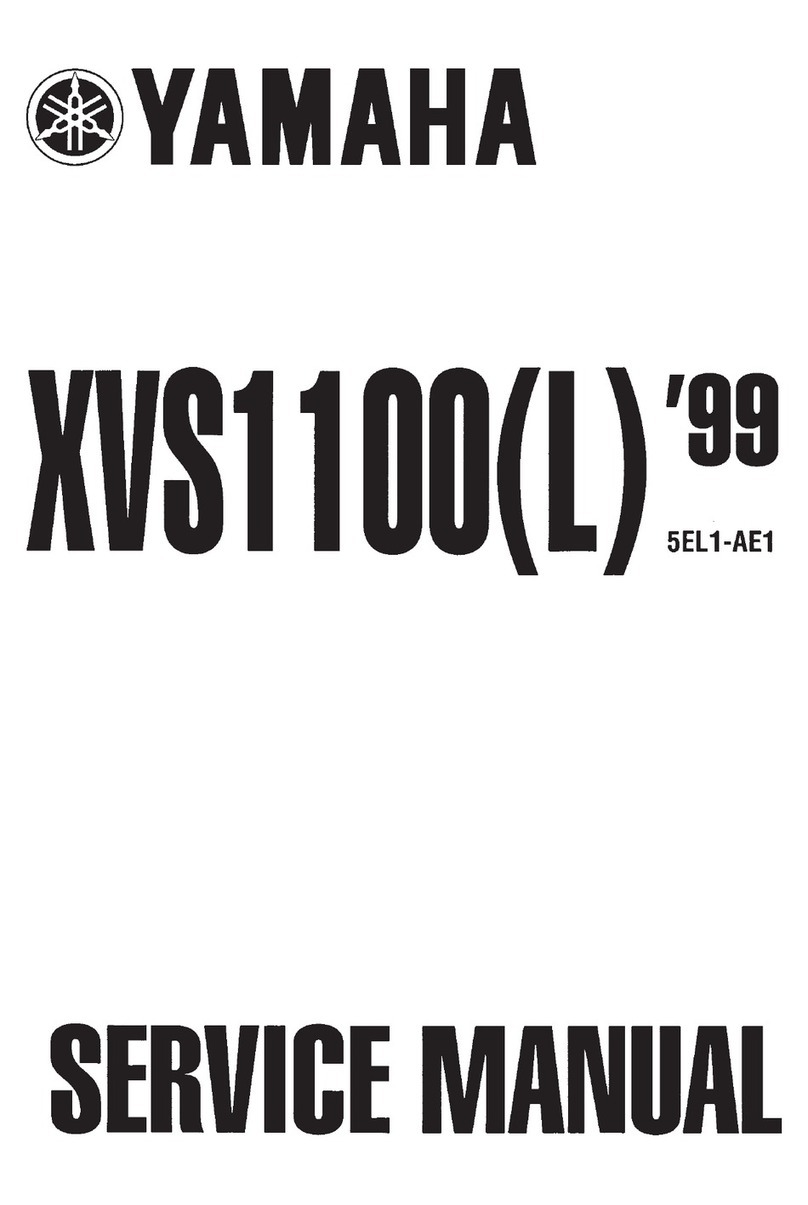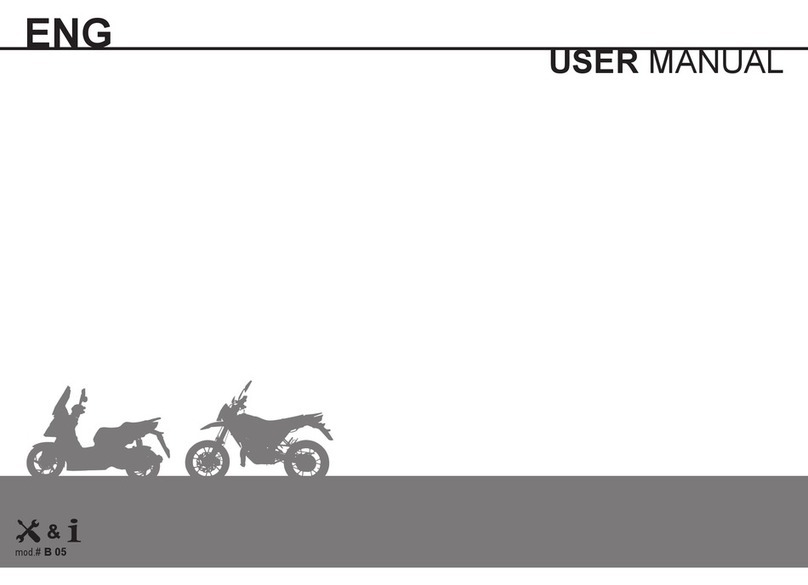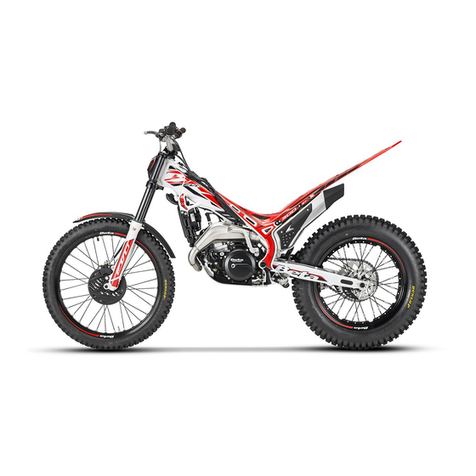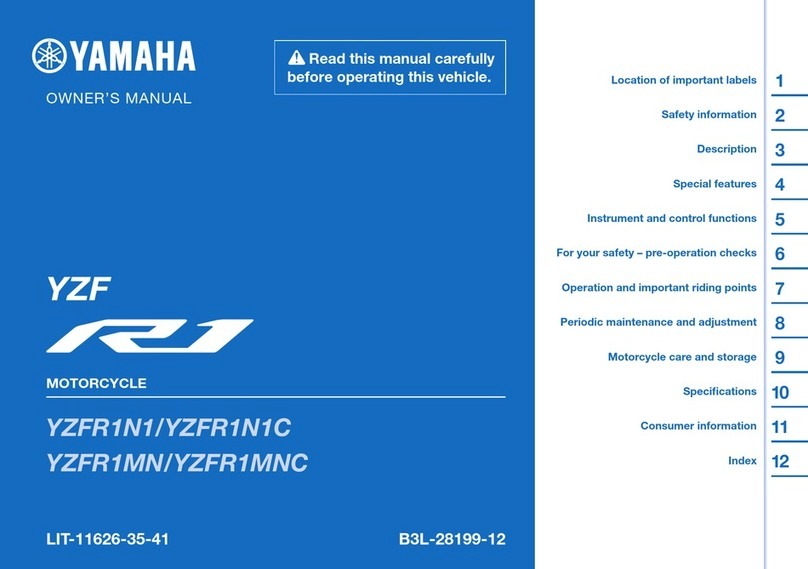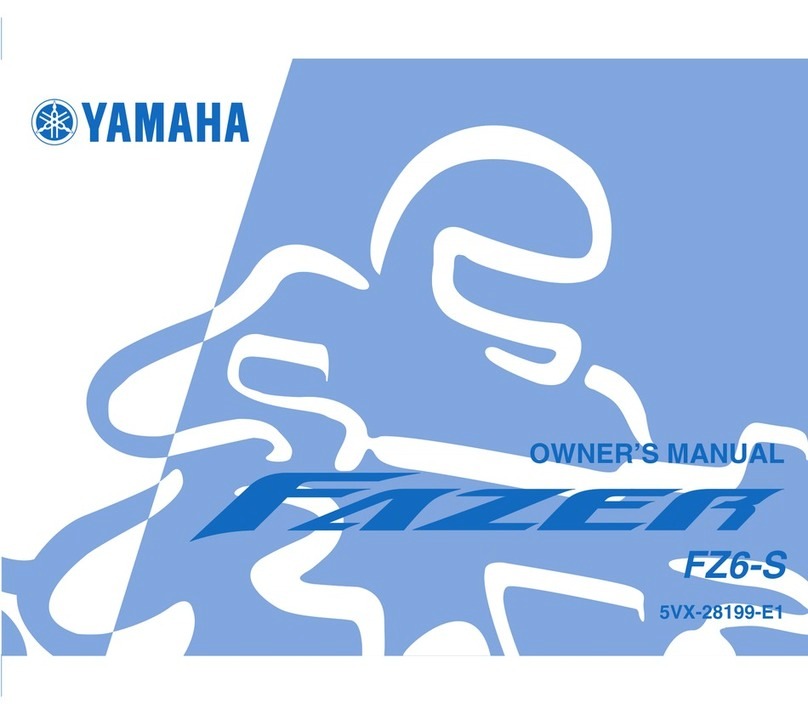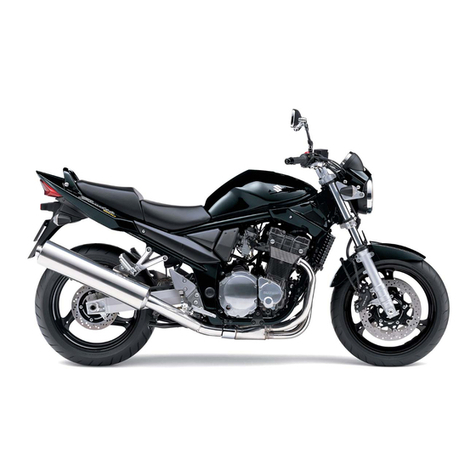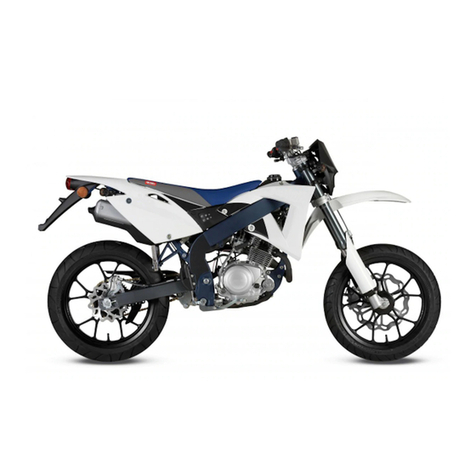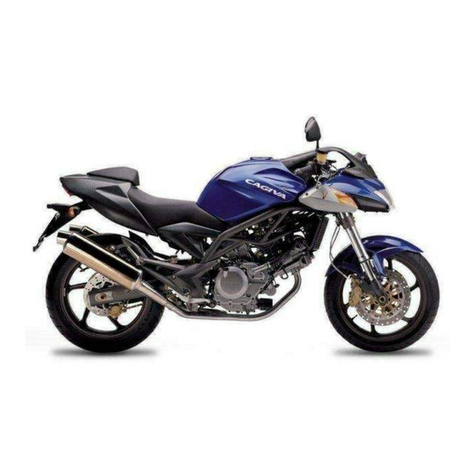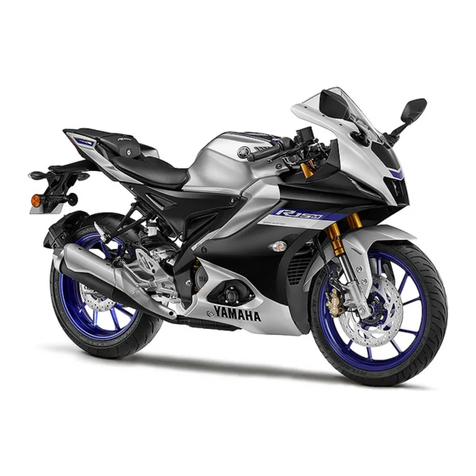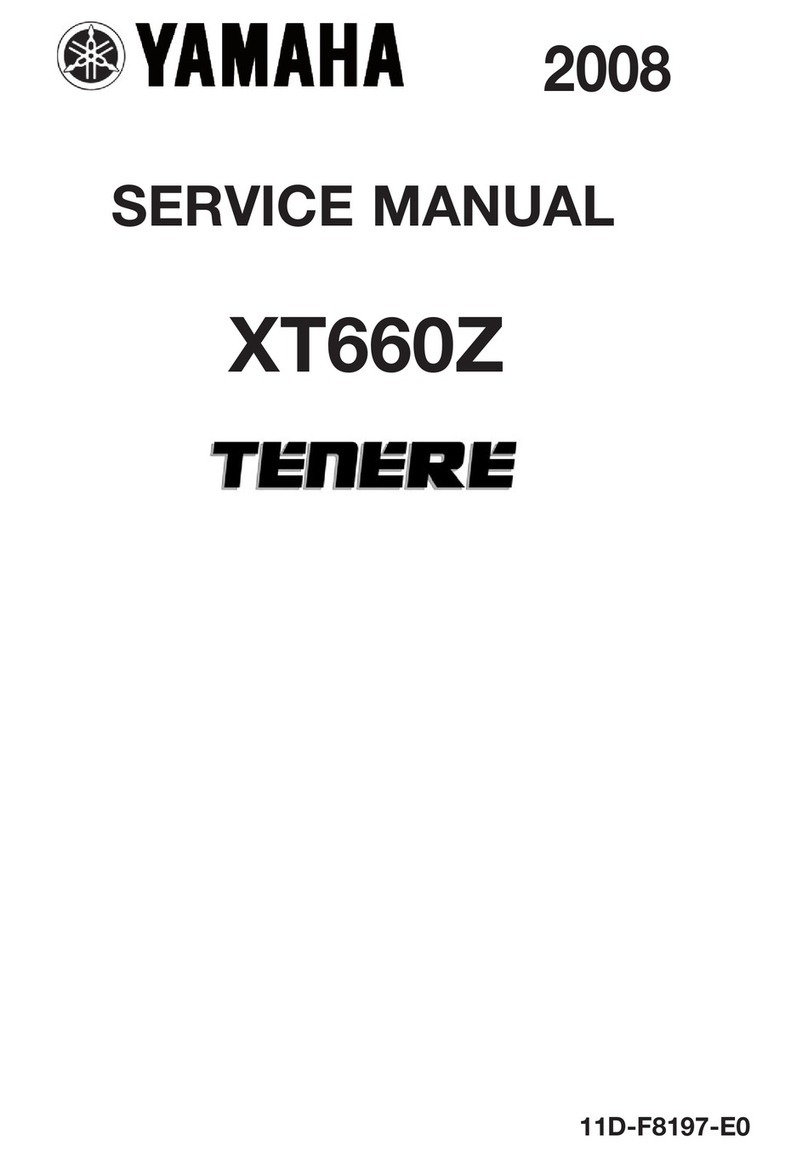Silicon Graphics Saskatchewan Motorcycle User manual

)
Saskatchewan Motorcycle Driver’s Handbook
A Guide to Safe Driving
safety

Introduction
Much of the content of this handbook was originally published by
the Ontario Ministry of Transportation and Communications and
has been reprinted with permission.
This handbook is not intended to be a complete digest of rules of
the road. It is merely a reference source covering those basic
pertinent points related to motorcycle driving which experience
has shown to be most important. For the purpose of interpreting
and applying the law, the official statutes should be consulted.
1
Saskatchewan Motorcycle Driver’s Handbook
A Guide to Safe Driving

1. Table of Contents . . . . . . . . . . . . . . . . . . . . . . . . . . . 2
2. About This Manual . . . . . . . . . . . . . . . . . . . . . . . . . . 4
3. Preparing to Ride . . . . . . . . . . . . . . . . . . . . . . . . . . . 5
– Proper Clothing . . . . . . . . . . . . . . . . . . . . . . . . . . . . 5
Helmet . . . . . . . . . . . . . . . . . . . . . . . . . . . . . . . . . . . 5
Eye and face protection . . . . . . . . . . . . . . . . . . . . . 6
Clothing . . . . . . . . . . . . . . . . . . . . . . . . . . . . . . . . . . 6
– Know Your Motorcycle Controls. . . . . . . . . . . . . . . 8
– Daily Motorcycle Check . . . . . . . . . . . . . . . . . . . . 12
4. Precision – Learning to Control a Motorcycle
Like an Expert . . . . . . . . . . . . . . . . . . . . . . . . . . . . . 15
– Body Position. . . . . . . . . . . . . . . . . . . . . . . . . . . . . 15
– Turning . . . . . . . . . . . . . . . . . . . . . . . . . . . . . . . . . . 16
– Braking . . . . . . . . . . . . . . . . . . . . . . . . . . . . . . . . . . 16
– Shifting Gears . . . . . . . . . . . . . . . . . . . . . . . . . . . . 16
5. Perception and Prediction. . . . . . . . . . . . . . . . . . . 18
– Learning Good Perception. . . . . . . . . . . . . . . . . . 18
– Checking the Road Surface. . . . . . . . . . . . . . . . . 19
– Using Mirrors . . . . . . . . . . . . . . . . . . . . . . . . . . . . . 19
– Learning to Predict . . . . . . . . . . . . . . . . . . . . . . . . 20
– Headlight . . . . . . . . . . . . . . . . . . . . . . . . . . . . . . . . 21
– Clothing . . . . . . . . . . . . . . . . . . . . . . . . . . . . . . . . . 21
– Nighttime Visibility . . . . . . . . . . . . . . . . . . . . . . . . . 21
– Horn . . . . . . . . . . . . . . . . . . . . . . . . . . . . . . . . . . . . 22
– Signalling . . . . . . . . . . . . . . . . . . . . . . . . . . . . . . . . 22
– Brake Light. . . . . . . . . . . . . . . . . . . . . . . . . . . . . . . 22
– Left Turn in Front of Motorcycle. . . . . . . . . . . . . . 23
6. Position – Learning Your Place on the Road. . . 24
– Lane Position - Blocking. . . . . . . . . . . . . . . . . . . . 24
– Turning Position . . . . . . . . . . . . . . . . . . . . . . . . . . . 26
– Gates. . . . . . . . . . . . . . . . . . . . . . . . . . . . . . . . . . . 28
– Three-Second Rule . . . . . . . . . . . . . . . . . . . . . . . . 29
– Distance to the Side . . . . . . . . . . . . . . . . . . . . . . . 30
– Lane Changes . . . . . . . . . . . . . . . . . . . . . . . . . . . . 30
– Sharing Lanes . . . . . . . . . . . . . . . . . . . . . . . . . . . . 31
– Distance Behind. . . . . . . . . . . . . . . . . . . . . . . . . . 32
– Position for Seeing. . . . . . . . . . . . . . . . . . . . . . . . 32
7. Position for Being Seen . . . . . . . . . . . . . . . . . . . . 34
8. Riding at Night. . . . . . . . . . . . . . . . . . . . . . . . . . . . . 36
9. Handling Dangerous Surfaces . . . . . . . . . . . . . . . 37
2
1)Table of Contents

3
10. Riding in Bad Weather . . . . . . . . . . . . . . . . . . . . . . 39
11. Being in Shape to Ride Your Bike . . . . . . . . . . . . 41
12. Owning and Maintaining a Motorcycle . . . . . . . . 42
13. Emergencies . . . . . . . . . . . . . . . . . . . . . . . . . . . . . . 43
14. Group Riding . . . . . . . . . . . . . . . . . . . . . . . . . . . . . . 47
15. Carrying Passengers and Cargo . . . . . . . . . . . . . 49
16. Maintenance. . . . . . . . . . . . . . . . . . . . . . . . . . . . . . . 51
17. Driver’s Licence Information. . . . . . . . . . . . . . . . . 53
– Endorsement “6” . . . . . . . . . . . . . . . . . . . . . . . . . . 53
– Class 6 and Endorsement “M” . . . . . . . . . . . . . . 53
– Driver’s Licence Restrictions . . . . . . . . . . . . . . . . 53
– Becoming a Driver. . . . . . . . . . . . . . . . . . . . . . . . . 53
GDL . . . . . . . . . . . . . . . . . . . . . . . . . . . . . . . . . . . . 54
Knowledge tests . . . . . . . . . . . . . . . . . . . . . . . . . . 54
Vision test . . . . . . . . . . . . . . . . . . . . . . . . . . . . . . . 54
Road test . . . . . . . . . . . . . . . . . . . . . . . . . . . . . . . . 55
– Registering Your Motorcycle . . . . . . . . . . . . . . . . 56
Documents required . . . . . . . . . . . . . . . . . . . . . . . 56
Where to go. . . . . . . . . . . . . . . . . . . . . . . . . . . . . . 56
New residents . . . . . . . . . . . . . . . . . . . . . . . . . . . . 56
Insurance . . . . . . . . . . . . . . . . . . . . . . . . . . . . . . . . 57
Cancellation . . . . . . . . . . . . . . . . . . . . . . . . . . . . . . 57
Renewal information . . . . . . . . . . . . . . . . . . . . . . . 57
Provincial Sales Tax. . . . . . . . . . . . . . . . . . . . . . . . 57
– Motorcycle Equipment Standards . . . . . . . . . . . . 58
18. Electric Cycles and Scooters . . . . . . . . . . . . . . . . 59
Electric Assist Bicycle . . . . . . . . . . . . . . . . . . . . . . . . . . . . 59
Power Cycle . . . . . . . . . . . . . . . . . . . . . . . . . . . . . . . . . . . . 59

This manual incorporates the newest advances in motorcycling
and is designed for novices and experienced drivers alike.
It will provide you with the information, knowledge and skills you’ll
need to be a safe and knowledgeable rider. You should also have
a copy of the Saskatchewan Driver’s Handbook – A Guide to
Safe Driving, and be completely familiar with the information
contained in it.
In Saskatchewan, you are required to have a Class 6 driver’s
licence or an “M” endorsement on your Class 1 - 5 driver’s
licence to drive a motorcycle on streets and highways. However,
there is a restricted learner’s licence (Endorsement 6) which
permits you to practice your driving on public roads under certain
restrictions (see page 53).
This manual contains complete information on preparing to ride
your bike, covering such areas as proper clothing, helmet
regulations and knowing your motorcycle.
Most accidents involving motorcycles are due to lack of
experience. It takes a lot of practice and experience to ride a bike
well. You must know where to ride in your lane, how to react to
other drivers’ mistakes, how to see like an expert and be seen by
other motorists, and how to handle dangerous surfaces and
emergencies.
To ride well, you must be in good physical and mental condition
because handling a motorcycle demands more concentration and
is more tiring than driving a car.
Impaired driving is a serious problem, especially among motor-
cycle drivers. Alcohol seriously affects your mind and body. This
is why so many motorcyclists who have been drinking hop on
their bikes and end up dead or disabled.
Carrying passengers or cargo is more demanding than riding a
bike alone. This text explains what to watch for when there are
two on a bike.
The skills and procedures discussed in this handbook, together
with learning experiences on your motorcycle, can help you meet
the challenges of operating on our streets and highways. What
you learn will add to the pleasure of driving your bike.
4
2)About This Manual

Your chances of getting to your destination in one piece are
influenced by the things you do before starting out. Good riders
always begin a trip with:
1) Proper clothing.
2) A check of the motorcycle.
3) A test of the motorcycle’s operation.
Proper Clothing
Proper clothing includes:
1) An approved helmet.
2) Eye or face protection.
3) Protective clothing.
Helmet
An approved motorcycle helmet can protect you from serious
head injury. When a motorcycle falls, the rider’s head often
hits something hard, like pavement or a curb.
The human head is fragile and head injuries are often fatal
or crippling. Saskatchewan law says that riders and
passengers must wear approved helmets and have them
properly fastened. A surprising number of motorcyclists
killed in accidents were not wearing their helmets. Wear
your helmet every time you ride.
5
3)Preparing to Ride
helmet
face shield
jacket
gloves

Proper Helmet
A poor helmet will not provide adequate protection.
A helmet must:
1) Meet Saskatchewan standards (see page 58).
2) Have a strong chin strap and fastener.
3) Be free of defects such as cracks, loose padding, frayed
straps or exposed metal.
A one-piece full face helmet is recommended. It’s a good idea to
have a helmet that is a bright colour such as red, white, yellow or
orange. It should also have reflective material on the back and the
sides. However, check the manufacturer’s specifications before
using any adhesive on your helmet.
When selecting a helmet, make sure it fits properly. When you
put it on, make sure it is snug and the strap is securely fastened.
Studies of motorcycle crashes show that loose helmets are
ineffective because they come off in collisions.
Eye and face protection
Your eyes need protection from wind, dust, rain, insects and
small pebbles thrown up from vehicles ahead. If the motorcycle is
not equipped with a windshield that deflects the airstream away
from the driver’s face the operator must wear goggles, glasses or
a face shield. A face shield is best; it protects your whole face.
Eyeglasses are not made to protect riders. They will shatter if hit
by a flying object. If you wear glasses, also use a face shield.
To be effective, eye or face protection must:
1) Be free of scratches.
2) Be made of material that doesn’t shatter.
3) Give a clear view to either side.
4) Fasten securely so that it can’t be blown off.
5) Allow some air to pass through so it won’t fog.
6) Allow enough room for eyeglasses or sunglasses, if needed.
Tinted goggles or face shields should not be worn at night.
Clothing
Clothing can help protect you against injury in case of a fall and
is required for proper visibility – wear bright clothing and a vest.
Jacket and pants should cover your arms and legs completely.
They should fit snugly enough so they don’t flap and yet let you
move freely. Wear a jacket even in warm weather. Leather is best.
Nylon, vinyl and other sturdy synthetic materials offer some
protection against wind and bugs. However, in a crash, synthetic
materials will stick to the skin when skidding on grass or
pavement.
6
3)

In cold or wet weather, your clothes should keep you warm and
dry, as well as protect you against injury. You can’t properly
control a motorcycle if you are numb. Riding for long periods in
cold weather can cause severe chill and fatigue. A winter jacket
should resist wind and fit snugly at the neck, wrists and waist.
Rain suits should be of good quality, and be designed for riding.
Those that are not designed for motorcyclists may balloon up or
tear apart at highway speeds.
Boots or shoes should be sturdy and high enough to protect the
ankles. Soles should be made of hard, durable material. Heels
should be low so they don’t catch on rough surfaces. Don’t wear
shoes with rings or loose laces that may catch on controls.
Gloves are also important. They give you a better hold on the
handlegrips and controls. Gauntlet gloves are recommended
because they provide protection not only to fingers and knuckles,
but also to wrists in case of an accident.
7
3)

Know Your Motorcycle Controls
The beauty of motorcycle design is that all controls and other
important devices are within quick reach of the rider’s hands and
feet. All drivers should know where the controls are and will be
tested on their knowledge on the exam. For example, 18 key
controls and devices are visible from the saddle of a typical
motorcycle:
1) Speedometer and odometer
2) Tripmeter
3) Tachometer
4) Light switches
5) Ignition switch
6) Turn signal switch
7) Horn button
8) Fuel supply valve
9) Choke control
10) Throttle
11) Clutch lever
12) Front brake lever
13) Rear brake pedal
14) Gear selector pedal
15) Starter
16) Engine kill switch
17) Stand
18) Oil level window or dip stick
8
3)
1
2
3
4
5
6
7
8
9
10
11 12
15
16
13
14
18
17

It is important to become familiar with the motorcycle’s controls,
whether you’re learning to ride or you’re an experienced rider
driving an unfamiliar motorcycle. In fact, you should first check
that the motorcycle isn’t too heavy or too large for you to operate
comfortably. When sitting on the seat, you should be able to
place your feet flat on the ground.
The same controls may not be found in the same places on all
motorcycles. Check your owner’s manual for the exact location
and precise way to operate all controls and devices. The first
step in learning to ride a motorcycle is to learn the controls used
to operate the machine. You must be able to reach any control
without looking for it. With practice, you will be able to operate all
controls by reflex. Automatic response is required before you can
venture out into traffic.
Instruments
The following instruments are grouped in the centre of the
handlebars on most motorcycles:
— The speedometer indicates riding speed in kilometres per
hour or miles per hour.
– The odometer indicates total kilometres or miles accumulated
on the motorcycle.
– The tripmeter indicates kilometres or miles accumulated since
the last time it was set at zero.
– The tachometer indicates engine speed in revolutions per
minute (RPM) and shows with a red line the maximum RPM
the engine can safely attain.
– The high beam indicator light appears red or blue when the
headlight is on high beam.
– The neutral indicator light appears green when the
transmission is in neutral.
– The turn signal indicator light flashes amber when either left or
right signals are operating.
Ignition switch
The ignition key goes into the ignition switch located near the
centre of the handlebars or below one side of the fuel tank. ON
and OFF positions are standard. Some switches also have
LIGHTS and PARK positions. When the ignition is on, the engine
can be started in either the ON or LIGHTS position. The LIGHTS
position turns on the headlight and the taillight. The PARK
position turns on only the taillight. The key can be removed only
in the OFF or PARK position.
Light switches
If the ignition switch does not have a LIGHTS position, your
motorcycle will have a separate switch with which to turn on the
headlight and taillight. On all newer motorcycles, the headlight
and taillight come on automatically when the ignition is switched
ON and the engine is running.
A dimmer switch, generally located on the left handlebar and
operated by the left thumb, can be used to set the headlight on
low or high beam.
9
3)

Turn signal switch
The switch to control turn signals is usually located on the left
handlebar and is controlled with the left thumb. Move the switch
right to ‘R’ to flash the right turn signal lights. Move it left to ‘L’ to
flash the left signal lights.
Most motorcycle turn signals do not self-cancel after a turn, as an
automobile’s do. So, you must cancel the signal after each turn
or lane change. Failure to cancel a turn signal is as dangerous as
not signalling in the first place.
Brakelight
The brakelight is located on the rear fender and is activated when
either the front or rear brake is applied.
Horn button
Sound the horn by pushing the horn button located on the left
handlebar with your left thumb.
Fuel supply valve
The fuel supply valve is a petcock located below the fuel tank. It
controls the flow of gasoline to the engine. When the motorcycle
is not in use, the valve should always be turned to the OFF
position to eliminate the possibility of fuel leaking into the
crankcases or creating a fire hazard.
The valve must be turned to the ON position on many bikes for
fuel to flow to the engine and for it to start and run. The fuel tank
has a reserve section in case the main section runs dry. To
release the reserve supply, you must turn the valve to RESERVE
or RES, something which you should be able to do while you are
riding your motorcycle.
Choke control
The choke adjusts the mixture of gasoline and air supplied to the
engine and usually is used only when starting a cold engine. The
choke control is located on the engine or at the handlebars. To
start a cold engine, move the choke control to the ON position
and start the motorcycle. When the engine is warm, return the
choke control to the OFF position.
Throttle
The right handlegrip is the throttle that controls the flow of
gasoline to the engine and thus the speed of the engine and,
ultimately, the speed of the motorcycle. To increase speed, rotate
the throttle toward you with your right hand. To reduce speed,
twist the throttle away from you. The throttle must spring back to
the idle position if you remove your hand.
Clutch lever
The clutch lever is located in front of the left handlebar and is
operated when squeezed toward the handlegrip with the fingers
of the left hand. Squeezing the lever disengages the clutch and
disconnects the engine power from the rear wheel. Releasing the
10
3)

lever engages the clutch and provides power to the rear wheel.
Whenever you change gears, either up or down, you must first
disengage the clutch.
Front brake lever
Apply the front wheel brake by squeezing the lever on the right
handlebar toward the handlegrip with the fingers of your right
hand.
Rear brake pedal
Activate the rear wheel brake by pressing your right foot on the
pedal located in front of the right footrest (on most bikes).
Remember that the right hand controls the front brake while the
right foot controls the rear brake. They should be used together.
The engine of your motorcycle will also act as a brake when you
gear down or reduce throttle.
Gear shift
The gear selector pedal is located on the left side on most
motorcycles just ahead of the footrest. You shift gears by lifting or
depressing the pedal with your left toe.
Most motorcycles have four or five gears and a neutral position.
In neutral, the transmission is out of gear and power will not
reach the rear wheel.
The gear selector pedal should only be operated while the clutch
is disengaged. After you have squeezed the clutch lever with your
left hand, you can select the gear you need by lifting or
depressing the gear selector pedal with your left toe.
Starter
Most motorcycles have an electric starter operated by pushing
the starter button on the right handlebar.
Many bikes still have a kick starter, usually located above the
right footrest. It must be unfolded before it can be used to start
the motorcycle with a vigorous kick.
Engine-kill switch
The engine-kill switch is located on the right handlebar and is
usually red. It is used in an emergency to stop the engine quickly.
It may also be used to turn off the engine after a normal stop, but
be sure to turn off the ignition switch as well after using the kill
switch.
The engine will not start when the kill switch is in the OFF
position.
Stands
When motorcycles are parked, they are supported by either a
side stand or a centre stand. Larger models have both.
11
3)

A side stand extends downward from its position underneath the
motorcycle to support the motorcycle in a leaned position.
A centre stand is a sturdy, two-legged stand attached under-
neath the centre of the motorcycle frame. It can support the
motorcycle in an upright position.
Stands are held in their retracted position by spring mechanisms
and lowered for use by the rider’s foot.
Make sure your side stand is retracted before you start off.
Daily Motorcycle Check
With a little experience, you will become familiar with the motor-
cycle controls. If there’s anything wrong with the motorcycle, the
time to find out about it is before you are in traffic.
Here are the things you should check before every ride. Take a
look at the critical parts of your bike before starting out.
Tires
You have only two tires so you must keep them in good
condition. Check for:
1) Inflation
The motorcycle does not handle properly if the air pressure is
too low or too high. Check the owner’s manual for the right
amount of air.
2) Tread
Worn or uneven tread can make the motorcycle skid,
particularly on wet pavement. Once the centre wear bar is
exposed, you have only 1 mm of tread left. The tire must be
replaced.
3) Damage
Check for cuts or nails stuck in the tread. Also, check the
sidewalls for cracks. A blowout on a motorcycle can be
extremely dangerous.
Controls
The controls are mounted on the handlebars. The steering is
done in conjunction with your body by leaning. Make sure your
controls work before you start out.
Brakes
Try the front and rear brakes one at a time. Make sure each one
holds the motorcycle when it is fully applied.
Clutch and throttle
Make sure the controls work smoothly. The throttle should snap
back when you let go.
Cables
Check the cables for kinks or broken strands. If a cable breaks
while you are riding, it could cause an accident.
12
3)

Lights
Don’t put your faith in lights that may not work. Keep them clean
and check them regularly.
Turn signals
Check all four turn signal lights. Make sure they flash when they
are turned on and are bright enough to be seen.
Headlight
Check your headlight. In daytime, pass your hand in front of the
beam to make sure the headlight is really on. Try your dimmer
switch to make sure both high and low beams work.
Tail and brakelight
Try each of your brake controls and make sure that each one
activates your brakelight.
13
3)

Horn
Try the horn to be sure it will work if you need it!
Gas and oil
Check gas and oil levels before you start. Running out of gas is
inconvenient, and can also be dangerous if it happens where you
cannot get off the road quickly. You can check the oil through the
oil level window or on your dip stick.
Lack of oil can cause your engine to “seize.” This could lock the
rear wheel and make you lose control.
Mirrors
Clean and adjust both mirrors before you start. It is difficult – and
dangerous – to ride with one hand while you adjust a mirror.
Swing your mirrors out far enough to see around your body.
Adjust each mirror to show half the lane behind you and as much
as possible of the lane beside you.
14
3)

To control a motorcycle with precision, you have to be able to
make it go exactly where you want and at the right speed.
When you’re learning to ride, it’s important to develop proper
riding techniques right from the start. However, only a lot of
practice will ensure that you are able to control steering, throttle
and brakes precisely.
Body Position
To control a motorcycle well, your body must be in the proper
position.
Seat
Sit close enough to the handlebars to reach them with your arms
slightly bent. Bending your arms allows you to turn the handle-
bars without having to stretch.
Posture
Your body should be fairly erect. This lets you use your arms to
steer the motorcycle rather than to hold yourself up.
Hands
Hold the handgrips firmly so that you will not lose your grip if the
motorcycle bounces. Start with your wrists down. This will
prevent you from accidentally using too much throttle.
Knees
Hold your knees firmly against the gas tank. This will help you
keep your balance as the motorcycle turns.
Feet
Keep your feet firmly on the footrests. A firm footing is important
to help you maintain balance. Don’t drag your foot or walk the
bike when starting. If your foot catches on something, you could
lose control of the motorcycle.
Keep your feet near the controls. This lets you use the controls
quickly if you have to. Also, try to keep your toes up. If you let
them drop, they may get caught between the road and the
footrest.
15
4)Precision – Learning to Control a Motorcycle Like an Expert

Turning
New riders tend to have more trouble turning than experienced
riders. The only way to learn how to make good, precise turns is
to practise. Here are two important tips for practising:
1) Limit your speed. New motorcycle riders often take turns too
fast. When they can’t hold a turn, they end up crossing into
another lane of traffic or going off the road. Or, they brake too
hard and skid out of control.
Approach turns extra carefully until you learn to judge how fast
you can actually take a turn. It is much better to enter a turn
too slow rather than too fast. You should speed up as you
come out of a turn, rather than slow down or brake hard while
you’re in the turn.
2) Lean with the motorcycle. Some riders are afraid to lean with
the motorcycle. At normal road speeds you must lean to turn.
The sharper the turn and the faster you ride, the more you
must lean. You and the motorcycle must work together as a
unit.
Braking
Your motorcycle has two brakes. You need both of them to stop
effectively. The front brake provides about three-quarters of your
stopping power. Use both front and rear brakes in combination to
provide good control.
Here are some things to remember about braking:
1) Use both brakes every time you slow down or stop. If you use
the rear brake for “normal” stops, you may not have enough
skill to use the front brake properly when you really need it.
2) Apply both brakes at the same time.
3) Make sure all your braking is done prior to the turn.
Shifting Gears
There is more to shifting gears than simply getting the motorcycle
to accelerate smoothly. Sloppy shifting can cause accidents
when downshifting, turning or starting on hills.
The purpose of the gears in a motorcycle transmission is to
match the engine’s speed (measured by the tachometer in rpm)
with the motorcycle’s road speed (measured by the speedometer
in km/h or mph).
On most bikes, neutral is located between first and second gear.
Always start and shut off your bike in neutral.
When starting off from a standstill, you must shift the trans-
mission up through the gears so that the engine is able to
maintain the motorcycle’s road speed without turning too fast.
Your motorcycle owner’s manual has information on the range of
engine speeds at which the motorcycle was designed to be
16
4)

operated. The proper gear will also permit the engine to provide
sufficient power for the bike to accelerate if necessary.
When slowing down in traffic, or for road conditions, you must
shift down through the gears until an appropriate match is
obtained between engine and road speed. Remember to shift up
when the engine is turning too fast for the road speed and to
shift down when the engine is turning too slowly.
Shifting down is more difficult to do smoothly than shifting up –
and potentially more dangerous. You must open the throttle
slightly to increase engine speed as you shift down with the
clutch pulled in. If you don’t apply enough throttle, the bike will
lurch when you release the clutch. Shifting down without having
the engine speed up enough to match its speed with the
motorcycle’s speed may cause the rear wheel to skid.
Shifting in a turn
Do not upshift or downshift in a turn unless you can do it very
smoothly. A sudden change in power to the rear wheel can cause
it to lock or lose traction. The result can be a skid. It is best to
change gears before entering a turn.
Starting on a hill
It is more difficult to get the motorcycle moving on an upgrade
than it is on flat ground. There is always a danger of rolling
backward into someone behind you.
Here is what you have to do:
1) Use the front brake to hold the motorcycle while you start the
engine and shift into first gear.
2) Change to the foot brake to hold the cycle while you operate
the throttle with your right hand.
3) Open the throttle a little bit for more power.
4) Release the clutch gradually. If you release it too quickly, the
front wheel may come off the ground or the engine may stop
– or both.
5) Release the foot brake when the engine begins to take hold.
17
4)

Becoming a proficient motorcyclist is not easy. The skill of
handling the machine takes time and practice. In addition, expert
riders have learned perception and prediction. Their eyes and
minds are working all the time to keep them out of trouble.
Perception is seeing and understanding everything around
you that might be important. Prediction is figuring out what is
going to happen next. As you ride along, you have to see and
understand what is happening so you can predict. You have to
predict in order to be in the right place, at the right speed to
avoid surprises.
Traffic situations can be complicated. You often have to see and
understand many different things very quickly in order to predict
what will happen in traffic.
A defensive motorcyclist is one who is always prepared for the
errors of other drivers. For instance, you may have to predict
what several drivers at an intersection are all going to do at the
same time.
Learning Good Perception
The best way to stay out of trouble is to see it coming. Expert
riders have very few surprises on the road because they see and
understand possible problems before getting to them.
To have such good perception, experts have learned to look far
ahead. In the city, expert riders always look from one and a half to
two blocks ahead. On the highway, they look as far ahead as they
can see. Looking well ahead gives them plenty of time to adjust
to problems. It also helps them avoid panic stops or sudden
swerves that can cause even more trouble. (For more information,
see the Saskatchewan Driver’s Handbook.)
18
5)Perception and Prediction
Your visibility of traffic and road conditions ahead is better if you
do not follow the vehicle ahead too closely.

To develop expert rider perception:
1) Look ahead as far as you can see.
2) Keep your eyes moving. Don’t look at one place for more
than two seconds; trouble could be developing in one place
while you’re staring at another.
3) Use your height advantage. Look over or through the car in
front of you for cars stopping or turning ahead.
4) Check the roadside. Watch for cars that may leave the curb or
enter from side streets or driveways.
Sometimes you cannot see an area because your view is blocked
by a bridge or a truck. Good riders have good imaginations. Ask
yourself what might be there that you can’t see yet. What you
can’t see can hurt you.
Checking the Road Surface
Road conditions and surfaces cause more trouble for motor-
cycles than other vehicles. When looking ahead and scanning the
road, good riders always look for problem spots on the surface.
They learn to see these spots well ahead, so they don’t have to
look down at the road surface.
1) Keep checking the road surface ahead for slippery spots, bad
bumps, broken pavement, loose gravel, metal plates, polished
pavement, wet leaves or objects lying in the road.
2) When riding in winter conditions be alert for ice or snow
patches on the road.
3) Use caution on pavement markings for they are slippery.
Using Mirrors
Traffic behind is almost as important to the motorcycle rider as
traffic ahead. Good riders check their mirrors every few seconds
to keep track of traffic coming from behind. You should have a
good picture in your mind of what is back there so you won’t be
caught off guard when somebody passes you, and so you can
safely and quickly stop or swerve if an emergency develops up
front.
Mirror checks are especially important in these situations:
1) When you have to slow down or stop suddenly. There may be
someone behind you.
2) When you are stopped at an intersection.
In both situations, if the driver behind you isn’t paying attention,
he or she could be right on top of you before he or she notices
you are there. You have to be prepared to get out of the way.
3) Any time you turn. Watch cars behind you, especially if you
plan to slow down and turn where others may not expect it,
such as into alleys, driveways and side streets.
19
5)
Table of contents
